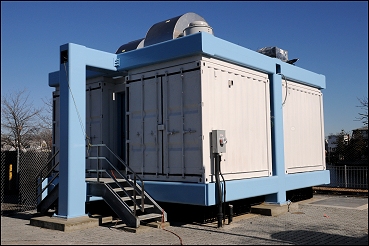FOR IMMEDIATE RELEASE12-09 February 6, 2012 CONTACT: Farrell Sklerov / Michael Saucier (718) 595-6600 DEP Completes Facility to Improve Ecology, Curb Odors in Jamaica Bay TributaryProject Uses Air Bubbles to Mix Water and Prevent Odor-Causing Temperature Layers in Shellbank Basin
"This is another bit of good news for New Yorkers who love Jamaica Bay," said Commissioner Strickland. "Living near the water is great, but not when it is so stagnant that it creates unwelcome odors. This facility addresses that issue as air will now be distributed throughout the water body, preventing the conditions that led to odors in the past and improving the overall ecology of the basin so that fish will want to remain." "I believe the DEP facility built near the Shellbank Basin is a step in the right direction environmentally," said State Senator Joseph Addabbo. "I am optimistic that the efforts of the DEP will improve the condition of the water in the basin, the quality of life for my constituents and the fish there, and eliminate the odors that have plagued the area for years. I am grateful for work done by DEP." "DEP has developed a creative, low-tech solution that addresses the occasional unpleasant odors in the waters of Shellbank Creek," said Council Member Eric Ulrich. "I applaud their efforts and thank the commissioner for making sure my constituents get the relief they deserve." "Our residents, particularly those in Howard Beach in close proximity to Shellbank Basin, are pleased that the permanent destratification system is complete," said Chairperson of Community Board #10 Elizabeth Braton. "DEP's work to provide a workable solution is much appreciated by all of us. We look forward to our summers to come without the odors and dead fish that prevented us from fully enjoying our unique waterfront location when inversions occurred."
The facility contains two compressors, one in operation and the other on standby, which will pump compressed air through the 3,800 feet of perforated tubing laid out along 2,000 feet of the basin floor. The pumping of compressed air mixes the water and prevents temperature stratification, or the formation of separate temperature layers in the water column. This allows for the distribution of oxygen throughout the basin, limiting the development of conditions that lead to low levels of oxygen. Earlier navigational alterations to the basin's original contours have reduced natural mixing and without that, the layer of water at the surface becomes much warmer due to heating by the sun, especially during the summer, while the deeper water layers are trapped on the bottom and remain cooler. This separation into warm and cool layers is known as stratification, and eventually the bottom waters become devoid of oxygen. Summer weather conditions then cause the basin to turn over, bringing water that is devoid of oxygen to the surface and causing ecological and odor problems. Shellbank Basin is bound by 157th Avenue to the north, Cross Bay Boulevard to the west and 85th Street to the east. The mouth of the basin is flanked by Frank Charles Park to the east and a portion of the Spring Creek Park to the west. The basin is approximately 5,200 feet long and is approximately 250 feet in width, on average. The basin is wider at its head with a width of approximately 550 feet. Depths in the basin range from 10 to 52 feet at mean low water. DEP manages the city's water supply, providing more than one billion gallons of water each day to more than nine million residents, including eight million in New York City. The water is delivered from a watershed that extends more than 125 miles from the city, comprising 19 reservoirs and three controlled lakes. Approximately 7,000 miles of water mains, tunnels and aqueducts bring water to homes and businesses throughout the five boroughs, and 7,400 miles of sewer lines and 95 pump stations take wastewater to 14 in-city treatment plants. DEP employs nearly 6,000 employees. DEP has a robust capital program with a planned $13.2 billion in investments over the next 10 years that creates up to 3,000 construction-related jobs per year. For more information, like us on Facebook at www.facebook.com/nycwater, or follow us on Twitter at www.twitter.com/nycwater. | ||
 Shellbank Basin Destratification Facility
Shellbank Basin Destratification Facility